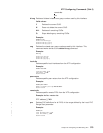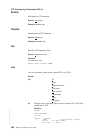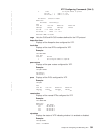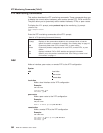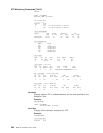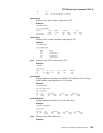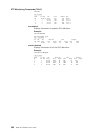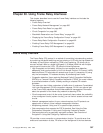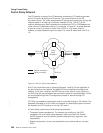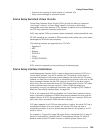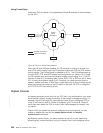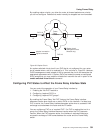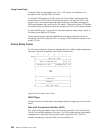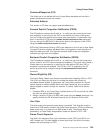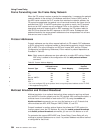
Chapter 30. Using Frame Relay Interfaces
This chapter describes how to use the Frame Relay interface and includes the
following sections:
v “Frame Relay Overview”
v “Frame Relay Network Management” on page 395
v “Frame Relay Data Rates” on page 396
v “Circuit Congestion” on page 399
v “Bandwidth Reservation over Frame Relay” on page 402
v “Displaying the Frame Relay Configuration Prompt” on page 402
v “Frame Relay Basic Configuration Procedure” on page 402
v “Enabling Frame Relay PVC Management” on page 403
v “Enabling Frame Relay SVC Management” on page 404
Frame Relay Overview
The Frame Relay (FR) protocol is a method of transmitting internetworking packets
by combining the packet switching and port sharing of X.25 with the high speed and
low delay of time division multiplexing (TDM) circuit switching. FR allows you to
connect multiple LANs to a single high-speed (1.54 Mbps) WAN link with multiple
point-to-point virtualcircuits (VCs). FR offers the following features:
v
High throughput and low delay.
Utilizing the
core aspects
(error detection,
addressing, and synchronization) of the Link Access Protocol, D-Channel (LAPD)
datalink protocol, FR eliminates all network layer (Layer 3) processing. By using
only the core aspects, FR reduces the delay of processing each frame.
v
Congestion detection.
Upon receiving Backward Explicit Congestion Notification
(BECN) or a Forward Explicit Congestion Notification (FECN), the router initiates
a controlled slowdown of traffic, thereby avoiding a complete FR network
shutdown.
The router can also initiate a slowdown of traffic when it receives a Consolidated
Link Layer Management (CLLM) congestion message. CLLM is an optional part
of the Frame Relay standards that provides additional management information
about the operation of the frame relay network to attaching DTEs.
v
Circuit access and control.
As the router dynamically learns about the availability
of non-configured circuits (orphan circuits), you can control access to those new
circuits.
v
Network management option.
As your network requires, the FR protocol can
operate with or without a local network management interface.
v
Multiplexing protocols.
Using one VC to pass multiple protocols.
v
Data compression
that supports the FRF.9 standard. See Using the Data
Compression Subsystem in
Using and Configuring Features
for details.
v
Data encryption
using a proprietary encryption scheme. See Overview of
Encryption in
Using and Configuring Features
for details.
FR provides no error correction or retransmission function. To provide error–free
end-to-end transmission of data, FR relies on the intelligence of the host devices.
© Copyright IBM Corp. 1994, 1998 387
|
|
|



